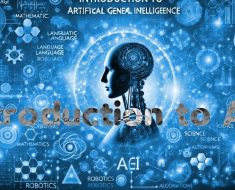Artificial general intelligence (AGI) describes AI that is capable of learning an intellectual task in the same way humans do.
| Aspect | Explanation |
|---|---|
| Definition | Artificial General Intelligence (AGI), also known as Strong AI or Human-Level AI, refers to a type of artificial intelligence that possesses the ability to understand, learn, and apply knowledge across a wide range of tasks and domains at a level equivalent to human intelligence. Unlike Narrow AI, which is designed for specific tasks, AGI systems have the capacity for generalization and can adapt to new and diverse challenges without the need for explicit programming. AGI is characterized by a high level of cognitive flexibility, reasoning, problem-solving, and the ability to perform tasks in a manner that mimics human intelligence. The development of AGI is a long-standing goal in the field of artificial intelligence and has the potential to revolutionize numerous industries and domains. |
| Key Concepts | – Cognitive Flexibility: AGI systems can adapt their knowledge and skills to perform a wide range of tasks. – Generalization: They can apply knowledge and skills across different domains, tasks, and contexts. – Autonomy: AGI operates independently, making decisions and learning without human intervention. – Human-Level Performance: AGI aims to achieve or surpass human-level performance across various cognitive tasks. – Learning Abilities: These systems have the capacity to learn from data and experiences, improving over time. – Problem-Solving: AGI is proficient in complex problem-solving and decision-making tasks. |
| Characteristics | – Adaptability: AGI can adapt to new tasks and domains without reprogramming. – Autonomy: These systems operate independently, making decisions and learning from interactions. – Human-Like Reasoning: AGI exhibits reasoning and problem-solving abilities similar to humans. – Generalization: They generalize knowledge and skills across diverse tasks. – Learning and Improvement: AGI continuously learns and improves its performance over time. – Wide Applicability: AGI has applications across various industries and domains. |
| Implications | – Revolutionary Impact: AGI has the potential to revolutionize industries, automate complex tasks, and solve previously unsolvable problems. – Ethical and Safety Concerns: Concerns arise about the ethical use of AGI and ensuring its safe development and deployment. – Labor Market Disruption: The widespread adoption of AGI could disrupt labor markets by automating a wide range of jobs. – Technological Advancement: AGI development pushes the boundaries of AI technology and computing power. – Data and Privacy: AGI systems rely on large volumes of data, raising privacy and security issues. |
| Advantages | – Versatility: AGI can perform a wide range of tasks, making it highly versatile. – Problem-Solving: Proficient in complex problem-solving and decision-making. – Efficiency: Can automate tasks and processes more effectively than Narrow AI. – Innovation Catalyst: AGI can drive innovation by addressing complex challenges. – Reduction of Human Error: Minimizes human errors in various tasks. – Learning and Adaptation: AGI systems continuously improve their performance through learning. |
| Drawbacks | – Ethical Concerns: Ethical dilemmas may arise in the use of AGI, such as decision-making biases and accountability issues. – Safety Risks: Ensuring the safety of AGI systems is challenging, as they can make autonomous decisions. – Labor Disruption: Wide adoption of AGI could lead to job displacement and socioeconomic challenges. – Complex Development: Developing AGI is a complex and resource-intensive endeavor. – Privacy Issues: AGI often relies on sensitive data, raising privacy and security concerns. – Regulatory Challenges: Regulatory frameworks for AGI are still evolving, leading to uncertainty. |
| Applications | AGI has applications across numerous domains, including healthcare, finance, autonomous vehicles, natural language understanding, robotics, scientific research, education, and more. Its versatility allows it to tackle complex problems in various industries. |
| Use Cases | – Autonomous Vehicles: AGI can enable self-driving cars to make real-time decisions in complex traffic scenarios. – Healthcare Diagnosis: Used for diagnosing diseases from medical images and assisting in treatment recommendations. – Conversational AI: AGI powers chatbots and virtual assistants capable of natural language understanding and conversation. – Financial Analysis: Utilized for data analysis, risk assessment, and investment strategies. – Scientific Discovery: Helps analyze vast datasets in fields like genomics, chemistry, and astronomy. – Education: Supports personalized learning and tutoring systems. – Robotic Assistance: AGI-enabled robots can perform tasks in unstructured environments. – Natural Language Translation: Translates languages accurately and contextually. – Content Generation: Generates creative content, including art, music, and literature. – Game Playing: Achieves superhuman performance in complex games like chess and Go. – Cybersecurity: Enhances threat detection and response through pattern recognition. |
Understanding artificial general intelligence
Artificial general intelligence is the representation of general human cognitive abilities in software that enables AI to solve problems in the same way a person does.
The precise definition of AGI varies from one expert to the next since each approaches the subject of human intelligence from a different perspective.
Psychologists, for example, may define it as the ability to adapt and survive while computer scientists may consider intelligence to be more related to goal achievement.
In any case, AGI is believed to be a form of strong artificial intelligence. This form contrasts with weak or narrow AI that is used to perform specific tasks or solve specific problems.
Autonomous vehicle technology and IBM’s Watson supercomputer are two such examples.
At present, AGI is a theoretical construct and remains the stuff of science fiction. When Gato was released by Alphabet subsidiary Deepmind in May 2022, it was touted as a “generalist agent” that could perform over 600 tasks from captioning an image to driving a robot.
Gato is probably the most advanced AI system in the world, but it can only make inferences from the information stored in its giant database.
For AGI to come to fruition, many argue it will require innovators to do more than simply force algorithms to parse more data.
On the subject of when artificial general intelligence may materialize there is much debate. Some academics believe AGI is decades away, while others predict the technology will not be developed this century.
Some, such as MIT roboticist Rodney Brooks, argue that AGI will not arrive until after the year 2300.
Characteristics of artificial general intelligence
While artificial general intelligence remains theoretical, there is scope that the performance of an AGI system will not only be indistinguishable from a human but far exceed it.
This is because these systems will likely possess comprehensive cognitive computing capabilities and the ability to process vast data sets at incredible speeds.
Nevertheless, some of the human characteristics artificial general intelligence must be able to replicate include:
- Common sense.
- The ability to understand cause and effect.
- Transfer learning – the application of knowledge learned from completing one task to solving a different but related problem.
- Abstract thinking.
- Sensory perception – this includes subjective color perception and depth perception in static images.
- Fine motor skills.
- Superior navigation skills – while existing GPS can pinpoint a specific location, it is envisioned that AGI will be able to better project movement through physical spaces.
- Natural language understanding (NLU) – this would require AGI to possess a level of intuition enabling it to understand human language which is heavily context-dependent.
- Other capabilities such as the comprehension of belief systems, symbols, and metacognition which includes self-awareness and critical thinking.
Key takeaways:
- Artificial general intelligence (AGI) describes AI that is capable of learning an intellectual task in the same way as humans do.
- While recent advancements in AI technology such as Gato have been commendable, AGI is at present a theoretical construct. Some experts believe it will take centuries for artificial general intelligence to be developed.
- With access to large datasets and superior processing power, there is scope that AGI may be able to outperform humans in the future. Before that happens, however, scientists must be able to replicate difficult human characteristics such as abstract thinking, fine motor skills, and sensory perception, among many others.
Read Next: AI Chips, AI Business Models, Enterprise AI, How Much Is The AI Industry Worth?, AI Economy.
Read Next: History of OpenAI, AI Business Models, AI Economy.
Connected Business Model Analyses
AI Paradigm





Like most processes, the quality of the inputs determines the quality of the outputs in prompt engineering. Designing effective prompts increases the likelihood that the model will return a response that is both favorable and contextual.
Developed by OpenAI, the CLIP (Contrastive Language-Image Pre-training) model is an example of a model that utilizes prompts to classify images and captions from over 400 million image-caption pairs.
OpenAI Organizational Structure




Stability AI Ecosystem

Additional resources:



![Large Language Models for Propaganda Span Annotation. (arXiv:2311.09812v2 [cs.CL] UPDATED)](https://aigumbo.com/wp-content/themes/sociallyviral/images/nothumb-sociallyviral_related.png)
![[2310.04270] A Comprehensive Evaluation of Large Language Models on Benchmark Biomedical Text Processing Tasks [2310.04270] A Comprehensive Evaluation of Large Language Models on Benchmark Biomedical Text Processing Tasks](https://aigumbo.com/wp-content/uploads/2023/12/arxiv-logo-fb-235x190.png)